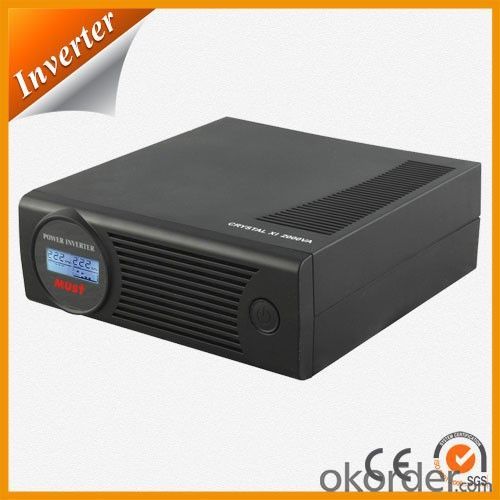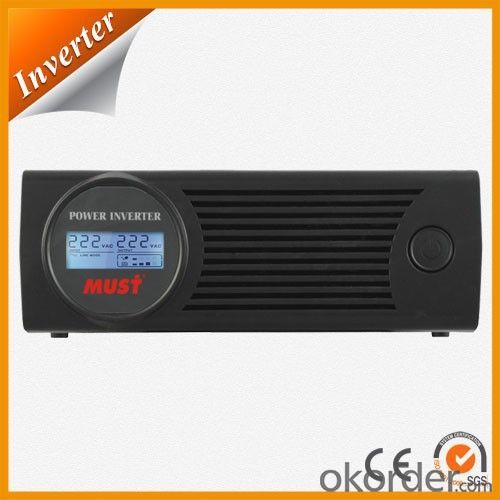Solar Power Inverter CE Approved EP1000 with Competitive Price
- Loading Port:
- China main port
- Payment Terms:
- TT or LC
- Min Order Qty:
- 50 unit
- Supply Capability:
- 1000 unit/month
OKorder Service Pledge
OKorder Financial Service
You Might Also Like
Features:
Main for home and office Appliance such as TV,refrigerator,fan,lights,computer etc.
1.User selectable for accepting wider input voltage.
2.Rack Tower design, high Frequency, off mode charging.
3.Compact size for convenient use and storage.
4.Built-in from 8Amp super charger up to 100Ah battery.
5.Small scale and cost effective inverter for home appliances and office equipments
6.Three – steps Three – steps intelligent charging control to recharging time.
NEW Function:10A/20A charging current adjustable .
Four new panel for your reference
Front panel & Sockets
Inside Structure
Rated Capacity | 500VA/300W | 1000VA/600W | 2000VA/1200W |
Input | |||
Models | 120V Models | 230V Models | |
Nominal Voltage | 110V/115V/120V Selectable | 220V/230V/240V Selectable | |
Input Frequency | 47Hz ~ 65Hz, 50/60Hz Auto-Sensing | ||
Efficiency | 95%(Normal Mode) | ||
Noise Filtering | Full Time EMI/RFI Filtering | ||
Over Current Protection | By Re-Settable Over Current Protector | ||
Voltage Range | 90 - 145VAC Or 170-280VAC ( Narrow Range ) | ||
Surge Protection | 324 Joules | ||
Output | |||
Rated Power | 500va/300w | 1000VA/600W | 2000VA/12000W |
Output Voltage | 100V/110V/115V/120V Selectable | 220V/230V/240v selectable | |
Voltage Waveform | Modified Sine Wave | ||
Crest Factor | 3:01 | ||
Output Frequency (Synchronized-Mains) | Auto Select For 50/60Hz 47Hz ~ 55Hz For 50Hz Nominal; 56Hz ~ 65Hz For 60Hz Nominal | ||
Regulation(Battery Mode) | 10% -18% | ||
Transfer Time | 15ms Typical 50ms Max | ||
Protection | Over Load, Discharge, Overcharged | ||
Battery Type | Lead-Acid 12V 25Ah ~ 250Ah | ||
Voltage | 500VA/1000VA :DC12V ; 2000VA :DC24V | ||
Backup Time | Depend On Battery | ||
Charging Method | 3 Steps Super Charge Mode | ||
Charging Current | 10A-20A Adjustable Charge Current | ||
Protection | Over Current Protection Over Charging Voltage Protection (No More Than 15V) Deep Discharge, Overload Protection | ||
Communications & Management | |||
Control Panel(LCD Indicator) | Input & Output Voltage, Battery Capacity, | ||
Audible Alarm | Low Battery | Sounding Every 2 Seconds | |
Overload | Sounding Every 0.5 Second | ||
Fault | Continuously Sounding | ||
Environment And Safety | |||
Operating Environment | 0~40 Degrees Centigrade, 0 - 90% Non Condensing | ||
Transit/Storage | -15℃ To 55℃ (5℉ To 131℉) D39 | ||
Operating Altitude | 0 ~ 3000 Meters | ||
Audible Noise | ≦50dba | ||
Safety Markings | CE.FCC | ||
Quality Control System | ISO 9001 | ||
Physical | |||
Dimensions (H×D×W) | 355*130*230mm | ||
N.W/G.W(Kg) | 1.6/2 (Kg) | 2/2.3 (Kg) | 2.2/2.6 (Kg) |
Packing | 6pcs/Carton | ||
Warranty
provides a 1~3 year limited warranty (“Warranty”) against defects in materials and workmanship for its Uninterruptible power supply, Power inverter/chargers, Solar charge controllers, Battery Products (“Product”).
The term of this Warranty begins on the Product(s) initial purchase date, or the date of receipt of the Product(s) by the end user, whichever is later. This must be indicated on the invoice, bill of sale, and/or warranty registration card submitted to MUST-Solar. This Warranty applies to the original MUST-Solar Product purchaser, and is transferable only if the Product remains installed in the original use location.
FAQ
1. How do I decide which system is right for me ?
For protection from long outages, include a generator or solar panels in your Must solar system. Shorter outages can be handled by a battery-only system.
2. Where my system will be installed ?
Must solar systems are usually wall-mounted near a home's main electrical (circuit breaker) panel.
3. How do I install my system ?
A must solar backup inverter is connected to a home electric system , we will supply detailed installation manual and videos for our customers .
Images


- Q:How does a solar inverter handle voltage regulation during sudden load changes?
- A solar inverter handles voltage regulation during sudden load changes by continuously monitoring the voltage levels and adjusting the power output accordingly. When there is a sudden increase in load, the inverter will automatically increase its power output to meet the demand and maintain a stable voltage. Conversely, if there is a sudden decrease in load, the inverter will reduce its power output to prevent voltage spikes and maintain a consistent voltage level. This dynamic response allows the solar inverter to effectively regulate voltage during sudden load changes and ensure the stability and reliability of the solar power system.
- Q:How does a solar inverter handle partial shading on solar panels?
- A solar inverter handles partial shading on solar panels by utilizing a technique called Maximum Power Point Tracking (MPPT). MPPT allows the inverter to continuously track the optimal operating point of each individual solar panel, even if some panels are partially shaded. By constantly adjusting the voltage and current levels of the panels, the inverter ensures that the shaded panels do not significantly affect the overall system performance, maximizing the energy output of the entire solar array.
- Q:Can a solar inverter be used in parallel configurations for increased power output?
- Yes, a solar inverter can be used in parallel configurations for increased power output. By connecting multiple inverters in parallel, the overall power output can be increased, allowing for the utilization of larger solar arrays and maximizing the energy generation capacity.
- Q:What is the role of an isolation transformer in a solar inverter?
- The role of an isolation transformer in a solar inverter is to provide electrical isolation and safety. It separates the input and output circuits, preventing any direct electrical connection between them. This isolation helps protect the inverter and its connected devices from electrical faults, such as ground faults, and reduces the risk of electric shock. Additionally, the isolation transformer can also help reduce common mode noise and provide better power quality by reducing the effects of electromagnetic interference.
- Q:How does a solar inverter affect the overall system efficiency at different temperatures?
- A solar inverter can affect the overall system efficiency at different temperatures by adjusting its power conversion efficiency based on the temperature conditions. In hot temperatures, solar inverters can experience lower conversion efficiencies, resulting in decreased overall system efficiency. This is due to increased internal resistance and heat losses in the inverter components. On the other hand, in colder temperatures, the inverter can operate more efficiently, as lower temperatures generally lead to reduced internal losses and improved performance. Therefore, the temperature conditions can have an impact on the efficiency of a solar inverter and subsequently affect the overall system efficiency.
- Q:Can a solar inverter be used with a single solar panel?
- Yes, a solar inverter can be used with a single solar panel. The purpose of a solar inverter is to convert the direct current (DC) produced by the solar panel into alternating current (AC) that can be used to power electrical devices or be fed into the electrical grid. Even with a single solar panel, the inverter can still perform this function effectively.
- Q:Can a solar inverter be used with a hybrid solar power system?
- Yes, a solar inverter can be used with a hybrid solar power system. A hybrid solar power system typically consists of both solar panels and a secondary power source, such as batteries or a diesel generator. The solar inverter converts the direct current (DC) power generated by the solar panels into alternating current (AC) power that can be used to power appliances and devices in the home or business. Additionally, the solar inverter can also manage the flow of power between the solar panels, the batteries, and the grid, optimizing energy usage and ensuring a reliable power supply.
- Q:Can a solar inverter be used with different types of batteries?
- Yes, a solar inverter can be used with different types of batteries as long as the voltage and current ratings of the batteries are compatible with the inverter's specifications. However, it is important to ensure that the inverter is programmed or configured correctly to work with the specific battery chemistry and charging requirements to optimize performance and prevent any potential damage.
- Q:What is the role of a power control unit in a solar inverter?
- The role of a power control unit in a solar inverter is to regulate and control the flow of electricity from the solar panels to the electrical grid or to the connected load. It ensures efficient power conversion by managing voltage, current, and frequency, and provides protection against overvoltage, under voltage, and short circuits. Additionally, the power control unit may also include features like maximum power point tracking (MPPT) to optimize the energy output from the solar panels.
- Q:What is the maximum current output of a solar inverter?
- The maximum current output of a solar inverter depends on various factors such as its power rating, design, and specifications. Typically, solar inverters have a maximum current output ranging from a few amperes to several hundred amperes, depending on the specific model and capacity.
1. Manufacturer Overview |
|
|---|---|
| Location | |
| Year Established | |
| Annual Output Value | |
| Main Markets | |
| Company Certifications | |
2. Manufacturer Certificates |
|
|---|---|
| a) Certification Name | |
| Range | |
| Reference | |
| Validity Period | |
3. Manufacturer Capability |
|
|---|---|
| a)Trade Capacity | |
| Nearest Port | |
| Export Percentage | |
| No.of Employees in Trade Department | |
| Language Spoken: | |
| b)Factory Information | |
| Factory Size: | |
| No. of Production Lines | |
| Contract Manufacturing | |
| Product Price Range | |
Send your message to us
Solar Power Inverter CE Approved EP1000 with Competitive Price
- Loading Port:
- China main port
- Payment Terms:
- TT or LC
- Min Order Qty:
- 50 unit
- Supply Capability:
- 1000 unit/month
OKorder Service Pledge
OKorder Financial Service
Similar products
New products
Hot products
Hot Searches
Related keywords































